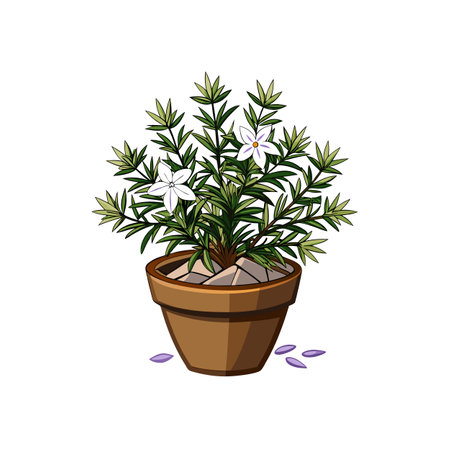1. Common Toxic Houseplants Found in UK Homes
When preparing your home for a new baby, it’s easy to overlook the potential risks posed by seemingly innocent houseplants. In the UK, many households feature both native and imported plants that can be harmful to babies if ingested or even touched. Popular choices such as Peace Lily (Spathiphyllum), English Ivy (Hedera helix), and Dieffenbachia (commonly known as Dumb Cane) are frequently seen on windowsills or in living rooms across Britain. While these plants add beauty and improve air quality, they contain compounds that can cause a range of reactions—from mild skin irritation to more serious symptoms like vomiting or breathing difficulties if your little one manages to chew on a leaf. Even classic British favourites like Daffodils and Foxgloves, sometimes kept indoors in vases, should be handled with care around infants. With imported varieties readily available in garden centres and supermarkets, it’s important for parents and carers to recognise which plants may pose hidden dangers within the home environment.
2. Hidden Dangers: Everyday Household Products
When preparing your home for a new baby, it’s easy to focus on the obvious risks such as sharp corners and stairs. However, many everyday household products commonly found in UK homes can contain hidden toxins that may put babies at risk. From cleaning sprays under the kitchen sink to scented candles on the mantelpiece, some of our favourite items might be more harmful than we realise.
Common Toxic Household Products
The table below highlights some typical household products and the toxic ingredients they may contain. These substances are not only dangerous if ingested but can also be harmful when inhaled or absorbed through the skin—an important consideration for curious little ones who love to explore with all their senses.
| Product | Potential Toxins | Possible Risks |
|---|---|---|
| Cleaning Supplies (bleach, disinfectants) | Sodium hypochlorite, ammonia, phenols | Respiratory irritation, skin burns, poisoning if swallowed |
| Scented Candles | Paraffin wax, artificial fragrances, phthalates | Indoor air pollution, headaches, hormone disruption |
| Air Fresheners (plug-ins, sprays) | Volatile organic compounds (VOCs), formaldehyde | Irritated lungs, allergies, potential carcinogen exposure |
| Laundry Detergents & Softeners | Optical brighteners, synthetic fragrances, surfactants | Skin rashes, allergic reactions, ingestion hazards |
| Pesticide Sprays & Rodent Poisons | Boric acid, organophosphates, anticoagulants | Acute poisoning, neurological effects |
Why Babies Are More Vulnerable in UK Homes
Babies’ developing bodies and immune systems make them especially susceptible to toxins. Their tendency to crawl on floors and put objects in their mouths increases exposure risks. UK homes often use tightly sealed windows for energy efficiency—which can reduce ventilation and allow toxic fumes from products like air fresheners or scented candles to linger longer indoors. Furthermore, many British households use multipurpose cleaners and strong disinfectants more frequently during cold and flu season, inadvertently raising exposure levels.
Safe Alternatives and Precautions for Parents
If you want to maintain a clean and pleasant-smelling home without compromising your baby’s health, consider switching to natural cleaning agents like vinegar or bicarbonate of soda. Opt for beeswax candles or open windows instead of synthetic air fresheners. Always store potentially hazardous products well out of reach and ensure good ventilation after cleaning. Making informed choices about what you bring into your home is a key step in creating a safe environment for your growing family.
![]()
3. Practical Tips for Identifying Toxic Items
Keeping your home safe for your baby means being proactive in recognising and labelling potentially dangerous plants and household products. Here are some practical guidelines tailored for UK households:
Spotting Hazardous Houseplants
Many common houseplants found in British homes, such as lilies, philodendrons, and poinsettias, can be toxic if ingested or touched by babies. Familiarise yourself with the scientific and common names of plants you own. Look up each one using trusted sources like the Royal Horticultural Society or NHS advice pages to determine its safety. When purchasing new plants, always ask the garden centre staff about toxicity, and keep tags or labels for future reference.
Checking Household Products
Everyday cleaning agents, air fresheners, and even some essential oils can be harmful to little ones. Always check packaging for hazard symbols, warnings, or phrases like “Keep out of reach of children.” In the UK, look for specific warning icons regulated by the EU/UK such as the exclamation mark or corrosive symbol. Avoid decanting chemicals into unmarked containers—this can lead to accidental misuse.
Effective Labelling Strategies
For both plants and products, clear labelling is crucial. Use easy-to-read sticky labels stating “Toxic – Keep Away from Children” or similar phrases. You might also want to colour-code plant pots (for example, red for hazardous) or use bold stickers on cupboards containing dangerous products.
Regular Reviews and Family Awareness
Make it a habit to review your home every few months for any new items or changes that might introduce risks. Educate all family members, including older siblings and grandparents, about which items are unsafe. This team approach ensures everyone is aware and vigilant.
By following these UK-specific guidelines for identification and labelling, you create a safer environment for your baby to explore while maintaining peace of mind as a parent.
4. Safe Alternatives for Baby-Friendly Homes
When creating a nurturing environment for your baby, it’s important to choose houseplants and household products that are both safe and sustainable. Many families in the UK are now opting for non-toxic plants and eco-friendly products to protect their little ones from unnecessary exposure to chemicals and potential allergens. Below, you’ll find recommendations tailored for British homes with babies.
Non-Toxic Houseplants Suitable for UK Families
Several beautiful and easy-to-care-for plants can brighten up your home without posing any risks to young children. Here’s a quick guide:
| Plant Name | Features | Care Tips |
|---|---|---|
| Spider Plant (Chlorophytum comosum) | Air-purifying, resilient, pet-safe | Indirect sunlight, water weekly |
| Boston Fern (Nephrolepis exaltata) | Humidity-loving, lush foliage | Mist regularly, keep soil moist |
| Bamboo Palm (Chamaedorea seifrizii) | Gentle on skin, air-cleaning | Bright, indirect light, moderate watering |
| Areca Palm (Dypsis lutescens) | Toxin-filtering, decorative fronds | Well-drained soil, avoid direct sun |
Eco-Friendly Household Products for Young Children
Selecting green cleaning solutions and household essentials is another step towards a safer home. Look for products with natural ingredients, free from harsh chemicals like bleach or ammonia. The following brands and options are widely available across the UK:
| Product Type | Recommended Brands/Options |
|---|---|
| Laundry Detergent | Ecover Non-Bio, Bio-D Laundry Liquid |
| Surface Cleaner | Method All-Purpose Cleaner, Ecozone Anti-Bacterial Spray |
| Washing-Up Liquid | Ecover Washing Up Liquid, Faith in Nature Lemon Washing Up Liquid |
Further Tips for a Safer Home Environment
- Avoid using air fresheners or candles containing synthetic fragrances; opt for essential oil diffusers instead.
- Choose toys made from natural wood or BPA-free plastics whenever possible.
- If you use paints or varnishes during nursery renovations, look for low-VOC or VOC-free options.
- Regularly ventilate rooms to minimise indoor air pollution.
Cultivating Peace of Mind Through Smart Choices
By choosing non-toxic plants and eco-friendly household products tailored to British homes, you not only create a safer space for your baby but also support their wellbeing as they grow. Small switches—like swapping out chemical cleaners for greener alternatives or introducing gentle houseplants—can have a meaningful impact on your family’s health and peace of mind.
5. Emergency Steps: What To Do If Exposure Occurs
If you suspect your baby has come into contact with a toxic houseplant or harmful household product, it’s essential to act quickly and calmly. Early intervention can make a significant difference in reducing the risk of serious harm. Here’s what you should do:
Immediate Actions
- Remove the Source: If possible, gently take away any plant material, soil, or residue from your baby’s mouth or skin. Avoid inducing vomiting unless specifically advised by a medical professional.
- Rinse Thoroughly: For skin exposure, rinse the affected area under lukewarm running water for at least 10 minutes. If there is eye contact, flush eyes with clean water for several minutes.
- Observe Closely: Watch for symptoms such as drooling, difficulty breathing, rash, swelling, vomiting, or unusual drowsiness.
NHS Guidance and Helpline Details
- Call NHS 111: For urgent advice and non-life-threatening emergencies, dial NHS 111. Trained advisers will guide you through next steps based on your baby’s symptoms and exposure details.
- 999 for Emergencies: If your baby is unconscious, having trouble breathing, or experiencing seizures, call 999 immediately for an ambulance.
Additional Resources
- The NHS Poisoning Advice page offers further information on what to do in cases of suspected poisoning.
- The Royal Pharmaceutical Society provides guidance on poison prevention and response.
Keep Key Information Handy
It’s wise to keep a list of emergency numbers—such as NHS 111, your local GP surgery, and nearby hospitals—somewhere accessible in your home. Acting swiftly and knowing where to seek help ensures the best possible outcome if accidental exposure occurs.
6. Creating a Secure and Nurturing Home Environment
After identifying and removing toxic houseplants and hazardous products, it’s essential to take proactive steps towards fostering a secure, nurturing home environment. Not only does this protect your baby from accidental exposure to harmful substances, but it also supports their overall wellbeing and development. Here are some practical suggestions tailored for UK families:
Prioritise Safe, Non-Toxic Alternatives
Choose non-toxic cleaning products, fragrance-free detergents, and natural air fresheners such as open windows or bowls of bicarbonate of soda. When selecting houseplants, opt for varieties like spider plants, Boston ferns, or African violets, which are known to be safe for homes with babies.
Create a Calm and Orderly Space
Babies thrive in calm environments. Reduce clutter by storing household chemicals and plant fertilisers out of sight and reach—preferably in high cupboards fitted with childproof locks. Use storage baskets or boxes to keep small items tidy and off the floor, minimising choking hazards.
Promote Healthy Air Quality
Ensure good ventilation by regularly opening windows—even in cooler months—and consider using air purifiers if needed. Avoid smoking indoors and steer clear of harsh chemical sprays that can linger in the air. A healthy atmosphere supports both physical health and emotional calm for everyone at home.
Emphasise Routine Safety Checks
Incorporate safety checks into your weekly routine: scan for dropped leaves or petals from houseplants, check for leaks or spills from cleaning products, and make sure all potentially dangerous items remain securely stored. These habits quickly become second nature and help maintain a consistently safe space for your little one.
Nurture Wellbeing Through Connection
Finally, remember that a truly nurturing environment extends beyond physical safety. Spend time together as a family in shared spaces—reading stories on the sofa, playing on clean rugs, or simply cuddling. Gentle routines and loving attention support your baby’s emotional security as much as any toxin-free policy.
A Holistic Approach to Family Health
By combining vigilant safety practices with mindful choices and daily bonding moments, you create a home where every family member can flourish—free from unnecessary risks and full of opportunities for growth and connection.


